Tag: Tony Wolf
The Big Chill — We Felt it through the Grapevine
It takes years of hard work to establish a vineyard, but only one bad night to lose it.
A week ago Wednesday, I thought that night was upon us. With subzero temperatures in the forecast, it seemed as though we might have been on the verge of losing our little hobby vineyard, which has been the focus of so much of our time and energy for the past four years.
To jump to the end of the story for just a moment, we spent a long day working in the vineyard on Thursday and a long night of checking the temperature on an hourly basis and begging the climate gods to show some mercy. And when I climbed out of bed Friday morning, I was feeling much more optimistic. We won’t know for sure until later in the year, but I believe that our vineyard survived, though not without some degree of injury to the vines.
We had known for several days that severely cold weather was on the way, but it had seemed as though it would be manageable. We monitor a number of weather services – WxRisk, Weather Underground, and the Weather Channel among them – and the latter two provided forecasts that varied daily. (They also vary between each other. Sometimes I pick the one I like best and lull myself into a false sense of security.)
So, the outlook for early Friday morning looked very different on Wednesday than it had only a few days earlier. Negative five degrees had been scary enough. But I was really surprised to see forecasts that warned of temperatures as low as minus 13 degrees Fahrenheit.
Now, our vines can do just fine in freezing weather, and they’ll even manage through sub-zero temperatures. At some point, though, you can expect injury. Everything I’ve read – I’ve never experienced it, but I’ve done a fair amount of reading – suggests that at negative five degrees we should expect to lose at least some of the buds that would produce shoots and grapes in the coming growing season.
And at negative 13?
Well, the damage could be catastrophic. Buds are more sensitive to the cold than trunks and canes, but only by a few degrees, according to Virginia Tech’s Tony Wolf, who was good enough to put out an alert Wednesday with lots of information about the effect of freezing weather on vines.
Losing a significant number of buds and part of next year’s harvest would be bad news. But it’s one thing to lose part of the crop and quite another to lose the entire vine. At some temperature, the scion – the actual vine, which is grafted onto rootstock – could be killed. If that happens, there’s little alternative but to replace the vine.
That would be disastrous for anyone, and my heart goes out to commercial vineyards that might have lost either a substantial portion of the 2015 crop or some part of their vineyard. For them, it’s everything. For us, it’s a hobby, not our livelihood, so it would be incredibly self-centered for me to complain too much about our potential loss.
Having said that, though, the prospect of losing vines hit me on a very personal level. We’ve spent more than four years getting to this point, and I feel like I remember almost every minute of the hard work and sacrifice.
But forget, for a moment, about the time we spent taking classes, reading and talking to vineyard managers to learn everything we could about viticulture. And forget about the cash outlays. Let’s also put aside the hours of physical labor that went into establishing the vineyard. (Well, not too far aside – I can still remember a day last summer, working five hours with a backpack sprayer and thinking I was just about ready to die by the time I finished.)
As important as all those things are, what matters most to me is the time – the number of years it takes to order vines, plant them, and nurse them through to their first harvest. We all have only so much time in this life. And that means we get only so many chances to get it right.
So yes, we could start over again. We could order vines, but we wouldn’t be able to get the vines we want this year, so we wouldn’t be able to plant until the spring of 2016. And it would be another three growing seasons before we harvest again. That would bring us to the fall of 2018, which seems like forever.
We did have a couple of things going for us. First, we had a couple of weeks of freezing weather leading up to the big chill, which helped harden off the vines. That meant they should have been able to withstand lower temperatures than would have been the case if the deep freeze had hit all at once.
Second, we had a blanket of snow on the ground. Snow has an insulating effect, and if it’s deep enough, it can protect the graft union, where the scion is joined to the root stock. In our first two years, we had hilled up around the vines, creating a mound of dirt a couple of inches above the graft union to provide the same kind of insulating effect. This year, with the harvest and all of the time and labor that goes into fermenting five different varieties of wine, we just didn’t get to it. Lesson learned.
Third, we’ve planted varieties that are reasonably cold-hardy, including Cab Franc, Petit Verdot, Petit Manseng, and Viognier. The exception is Merlot, which is much more sensitive to cold injury. The Merlot is also the youngest of the varieties we planted and therefore the least able to take winter’s punch.
For all that, though, we were pretty worried. By the end of the day Wednesday, the Vineyard Goddess and I had decided to spend Thursday doing everything we could to protect the vines. Our plan was to use mulched and partially composted leaves and grass to hill up around each vine, in the hope that we could insulate the graft union to the point that we could save the vine, if not this year’s harvest.
We traveled to Afton Wednesday night so that we could get an early start the next morning. Sometime around 8 a.m. Thursday we made our first foray into the vineyard. It was about 3 degrees above zero and the wind was blowing. I was colder than I think I’ve ever been in my entire life, and we went back inside to add a couple of layers of clothing, have a cup of coffee, and wait for the temperature to reach a more civilized 6 degrees or so.
By 9 a.m., we were working in earnest. Over the years, I had dumped a large volume of leaves and grass clippings into a heap on the other side of our property, and we had a very large pile by this point that was just waiting to be repurposed. I used the front-end loader on my tractor to haul them into the vineyard where the VG mounded them around each vine. Here and there we added some snow to pack the mulch down, but mostly, we relied upon the organic matter to insulate the vine.
The overnight temperature readings were somewhat milder than the forecast, but they were still pretty severe. At 7 a.m., the temperature hit minus 6.1 degrees, according to the Weather Underground station closest to us. I would have preferred to have our own weather equipment in the vineyard, but this station is not only close, it’s also at the same elevation as our vineyard, so I expected that the readings would be very close to what we would have gotten if we had a thermometer on our own property.
In the next week or so, we’ll be sampling buds and canes to see how well we survived the big chill. This is a first for us, and I have no idea how we did. But I can say this: I feel a whole lot better because of the work we did. Even if we lose the vineyard – which I think is a low probability outcome – I’ll feel better knowing that we did everything we could. If we had done nothing at all and lost only half the vineyard, I would feel much worse.
Wine grape growing is agriculture and like farmers everywhere, we live at the mercy of whatever Mother Nature throws at us. As Chris Hill, one of Virginia’s vineyard pioneers, told me during one of our classes – and this is a major paraphrase – the averages (temperature, etc.) are important, but it’s the records that kill you. And this year was one for the books.
A Holiday Book List for Wine Lovers
With the holiday season upon us, I can’t think of a better gift for someone you love (or even someone you don’t like all that much, but for some reason are obligated to buy a gift for) , than a book about wine, save perhaps for a bottle of the actual stuff. In the time since I started writing this blog, I’ve read a fair number of books on this subject, many of them about the process of growing grapes and turning them into wine, others on the joys of drinking wine, and still others on some topical issue, such as the touchy subject of natural wine.
With that in mind, I thought I’d list a few books that might make a nice gift for a friend or stocking-stuffer (yes, I know, that would be some big stocking – but you can just leave it under the tree). Most of these are books I’ve read and enjoyed, and some are volumes that I’ve put on my own list. Among those in the category of books I’ve loved, I’ve either reviewed them or have plans (and yes, I have more plans than time) to write a review on Project Sunlight. So, stay tuned. Meanwhile, here’s the list:
Some Books I’ve Loved
Of all the books I’ve read about wine, I’ve enjoyed none more than Authentic Wine by Jamie Goode and Sam Harrop MW (Master of Wine). 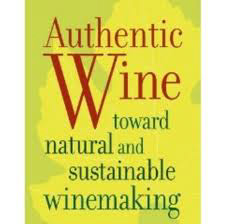 The book’s subtitle, Toward Natural and Sustainable Winemaking, gives a broad hint about where it’s heading, but one of the most appealing things about the book is its balance. The authors clearly respect the idea of natural wine and sustainable viticultural practices, but their first priority appears to be good wine, and they understand that a business isn’t sustainable if it isn’t profitable. Authentic Wine falls neatly into two parts, one dealing with viticulture and the second focusing on winemaking. I’ve read this book twice (you’d think after that I’d have taken the time to write at least a short review), and I’ll will probably read it yet one more time. They write intelligently and lucidly about a variety of current issues in the wine world, from reduction to the difference between natural and cultured yeasts to the trend toward riper fruit and higher alcohol levels. The get into the science and technical issues, but the writing is accessible and easy to follow. That’s quite a rare feat, and one of the reasons I’m so high on Jamie Goode.
The book’s subtitle, Toward Natural and Sustainable Winemaking, gives a broad hint about where it’s heading, but one of the most appealing things about the book is its balance. The authors clearly respect the idea of natural wine and sustainable viticultural practices, but their first priority appears to be good wine, and they understand that a business isn’t sustainable if it isn’t profitable. Authentic Wine falls neatly into two parts, one dealing with viticulture and the second focusing on winemaking. I’ve read this book twice (you’d think after that I’d have taken the time to write at least a short review), and I’ll will probably read it yet one more time. They write intelligently and lucidly about a variety of current issues in the wine world, from reduction to the difference between natural and cultured yeasts to the trend toward riper fruit and higher alcohol levels. The get into the science and technical issues, but the writing is accessible and easy to follow. That’s quite a rare feat, and one of the reasons I’m so high on Jamie Goode.
Also high on my list is Mike Veseth’s wonderful discussion of current wine industry trends, Wine Wars. (Reviewed March 28, 2013) Subtitled, “The Curse of the Blue Nun, the 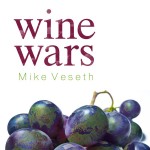 Miracle of Two-Buck Chuck, and the Revenge of the Terrorists,” this book ranges over a great deal of history to put some of the trends into context, and provides a lot of insight into some of the things, like Trader Joe’s and Costco, that are right in front of our eyes. Could a two-dollar (somewhat more outside of California) bottle of wine have succeeded if it had been sold anywhere else but at Trader Joe’s? In a world in which quality is often equated to price, it might not have worked at a retailer that had not already won the trust of its customers. And yet, in Europe, some perfectly drinkable wines sell (or at least sold recently) for a Euro a liter, making it effectively One-Buck Chuck. Mr. Veseth writes with the authority of the wine economist (a profession I did not know existed prior to reading this book), he is, and it’s clear that he not only knows a lot about wine, but that he loves it as well. The fact that his prose is both clear and engaging is just a bonus. Continue Reading–>
Miracle of Two-Buck Chuck, and the Revenge of the Terrorists,” this book ranges over a great deal of history to put some of the trends into context, and provides a lot of insight into some of the things, like Trader Joe’s and Costco, that are right in front of our eyes. Could a two-dollar (somewhat more outside of California) bottle of wine have succeeded if it had been sold anywhere else but at Trader Joe’s? In a world in which quality is often equated to price, it might not have worked at a retailer that had not already won the trust of its customers. And yet, in Europe, some perfectly drinkable wines sell (or at least sold recently) for a Euro a liter, making it effectively One-Buck Chuck. Mr. Veseth writes with the authority of the wine economist (a profession I did not know existed prior to reading this book), he is, and it’s clear that he not only knows a lot about wine, but that he loves it as well. The fact that his prose is both clear and engaging is just a bonus. Continue Reading–>
Of Hurricanes and Early Frosts
One of the lessons we’ve learned from this first year of vineyard management is that it can be very difficult to maintain vines from a distance. In the best of circumstances, it’s hard for us to be at a property that’s just over two hours from our residence any more often than once a week, and we rarely find ourselves in the best of circumstances. So we do the best we can, using our time as efficiently as possible to make sure the vineyard is well maintained, and that we keep to a reasonable spraying schedule.
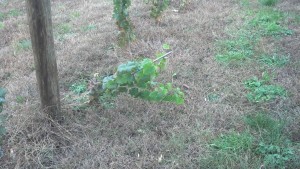
In the wake of Hurricane Sandy, we found a number of vines had been blown over, and were now leaning down almost to the ground. Not good.
Two weekends ago, after a longer than usual absence, we arrived in Nelson Country to survey damage from Hurricane Sandy and prepare for the freezing weather that had been predicted for that weekend. My apologies for taking so long to get this post up, but sometimes life gets in the way. And what with my surgery and a heavy worload back at the office on my day job, Project Sunlight has been a bit neglected. But I promise to rectify that, starting with this post, which covers Mother Nature at her worst — a hurricane, followed by early frost.
I’ll start with Sandy. We felt lucky, especially considering the devastation in New York and New Jersey, to have escaped with so little damage. I once lived on the New Jersey shore, and worked in both Jersey and New York city, and I felt deeply for the people there who suffered so much. For us, in both Fairfax and Nelson counties, the most visible sign that a storm had passed through were the fallen limbs and branches that will likely provide a whole winter’s worthy of kindling. But that’s not to say we escaped scot-free. As we walked through the vineyard, we saw a number of vines leaning sideways, in some cases almost to the ground. And no, that’s not a good thing. Continue Reading–>
The Perils of an Early Spring
We arrived home Sunday afternoon to find that the vines in our Fairfax vineyard were blooming in a magnificent way. I had pruned them during the winter, when they were still dormant, and have been wondering ever since if I had cut cut them back too severely. When I saw them on Sunday, though, I felt vindicated. Yes! Yes ! They would be up to the first wire (30 ” – or maybe 36″, I actually haven’t put the trellis in yet) in no time flat, I assumed.
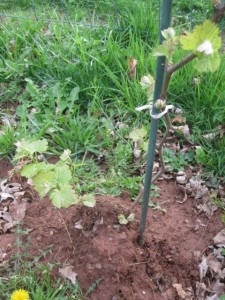
The Fairfax vineyard is a bit overrun with weeds right now, but you can see the leaves on this vine if you look closely.
I couldn’t have been happier. Until I showed the vines to my wife, the Vineyard Goddess.
“Well, that’s good and bad,” she said. Good, of course, because the vines looked so healthy and productive. But mostly bad, because, it’s still March and we could have some frost ahead of us. The bud break I observed on my vines had come very early in the season. And when she glanced over my shoulder at this post, she added another rule of thumb for vineyard management: “March will always be too early for bud break.”
And of course she was right. (She’s pretty much always right. Thank God she’s watching over our vineyard.) This evening, I found an email alert from Tony Wolf, the Virginia Tech viticulture specialist, and probably the state’s foremost expert on all things viticultural, warning of the likelihood of freezing temperature overnight. According to NOAA ‘s web site, temperatures will drop to about 31 degrees tonight in Afton, the site of our Nelson County vineyard, and 30 degrees in Fairfax, where the aforementioned vines are Continue Reading–>
In Search of a Few Good Vines
Now that we know what kinds of grapes we want to grow, it’s time to get down to the serious business of ordering vines and getting ready for spring planting. (Actually, this whole process has been serious business, but since the selection of grape varieties mostly involved visiting wineries and tasting wine, this part of the effort is serious in a somewhat different way.)
We began with some research on what clones have done well in Virginia. When you order vitis vinifera wines (which encompasses the European-style grapes most people are most familiar with, from Chardonnay to Cabernet Sauvignon), you’re making two decisions for each variety – the type of rootstock to use and the clone that will be grafted onto it. At a minimum, it’s important that rootstocks be resistant to such pests as phylloxera, the root louse that all but destroyed European vineyards in the 19thcentury, and nematodes, but we’re also looking for roots that will inhibit excessive growth, withstand cold winters, and work well in our soil, which is clay and loam. Long story short, we’ve pretty much decided to go with a root stock known as 101-14, the same root stock on the Cab Franc vines we’ve already planted in both the Fairfax and Nelson County vineyards.
Clones are more interesting, and they took a bit more time to figure out. Keep in mind that grape vines reproduce asexually. Cuttings from a Cab Franc are used to produce more Cab Franc
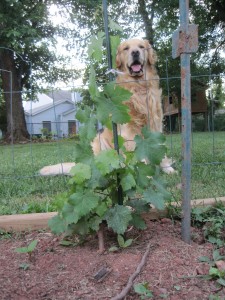
Here's a Cab Franc vine in the Fairfax vineyard (with Phoenix the Vineyard Dog standing guard) The clone is FPS 4, grafted onto 101-14 rootstock. The picture was shot a few months after planting.
vines, and it is presumed that the clone will exhibit the same qualities and characteristics as the vine it was taken from. But variations occur, and if a new vine exhibits differences that are deemed to be desirable, it may be characterized as a new clone and propagated more widely. So there isn’t just a single Viognier or a lone Cab Franc. There are a number of different Cab Francs, each classified as a separate clone, and each exhibiting different qualities, not just in the way they grow, but in the quality of the wine they produce.
So the choice of clones was very important to us. We relied heavily on Tony Wolf’s indispensible book,Wine Grape Production in Eastern North America, and came up with the following oddly-named clones (actually, all clones are oddly named; they sound a bit like the parts in an erector set) : For Cab Franc: ENTAV 214, 327, or 623 (whichever one we can get); for Petit Manseng: ENTAV 573; Petit Verdot, ENTAV 400, and Viognier: ENTAV 642. I mentioned Merlot in my last post, but we’ve pretty much decided that’s a clone too far for this year.
You can see that the clones we are most interested in all have the word ENTAV in their name. ENTAV (which stands for, Etablissement National Technique pour l’Amelioration de la Viticulture, or National Educational Association for Viticultural Improvement) are grapes of French origin, and sold in the United States through licensed nurseries. (By contrast, the clones we purchased early this year, referenced in the caption above, are FPS, which stands for Foundation Plant Services, the UC-Davis department that produces, tests, maintains and distributes premium foundation-level virus & disease-tested plant materials for use by California nurseries.)
We called one of the nurseries a few days ago, assuming that when we told them we planned to order a whopping 125 vines that they would fall all over themselves to help us, perhaps even offering to fly us out to California to get a look at the nursery. (You know I’m kidding, right? I would guess that their average order is measured in multiples of a thousand vines.) Our actual assumption is that we’d be able to get someone on the phone who could talk to us for a couple of minutes and then take our order and credit card number.
The nursery was Sunridge, which seems to be one of the very best in California, and the woman who worked with us could not have been friendlier or more helpful. Unfortunately, they didn’t have most of what we wanted. It turns out that they didn’t develop most of what we wanted “on spec” this year.
“On spec” seems to mean roughly the same thing in the grape vine nursery business as it does in the housing industry, where developers either build to order for a buyer who puts money down in advance, or build on spec in the hopes that buyers will show up with cash in hand. Whatever the case, they had the Viognier clones, but nothing else among our favorites.
Okay, that was a surprise. We had just assumed that everything on the web site would be immediately available and that all we had to do was call and ask for what we wanted. Now we are wondering if we will have to settle for clones that aren’t exactly what we want or wait another year to get clones of our dreams. Given that it takes a minimum of three years before the vines begin producing grapes, and a year or more after that before the wine is ready to drink, you only have so many chances in a single lifetime to get it right. And in our case, we only have so much land to devote to this enterprise. Putting off the planting for a year is not an option.
My wife, the Vineyard Goddess, sprang into action, and promptly identified a number of nurseries that distribute the varieties of grapes that we’re looking for. Great news! The bad news, however, was that only a handful sold the ENTAV clones we’re looking for.
We knew that there are only a limited number of ENTAV-approved nurseries in the United States, but we didn’t know how limited that number was. It turns out that only four nurseries in the U.S. are licensed to sell ENTAV clones, and two of them appear to have merged. Of the remaining two, one doesn’t have a web site, which is making it difficult to contact them, and the fourth has been a bit slow in getting back to us.
We think there might be other options, including Mercier California. According to the National Grape Registry, which is hosted by UC-Davis, Mercier has a presence in California. However, Mercier’s web site is tout en francias, and we are wondering if their ENTAV vines are shipped from France. Not that I care where they are shipped from. However, I do care about shipping costs. A friend who spent most of his life working vineyards in Bordeaux highly recommended Mercier, so we are hopeful that this is a viable option.
Okay, apparently purchasing vines isn’t as simple as logging into Amazon and selecting one-day shipping. But most of the things in life that are worthwhile require some extra work. And if anything warrants extra labor, it’s good wine. We’ll keep at it until we get it right. And with luck, we’ll be ordering those vines next week!

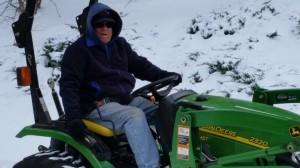
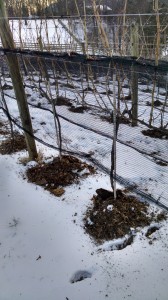
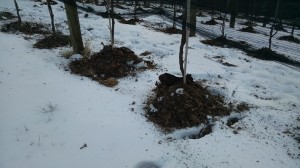


Recent Comments